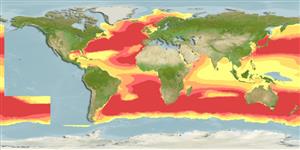Preferred temperature (Ref.
115969): 1 - 14.5, mean 7.8 (based on 1032 cells).
Phylogenetic diversity index (Ref.
82804): PD
50 = 0.8750 [Uniqueness, from 0.5 = low to 2.0 = high].
Bayesian length-weight: a=0.00102 (0.00046 - 0.00225), b=3.06 (2.88 - 3.24), in cm Total Length, based on all LWR estimates for this body shape (Ref.
93245).
Trophic level (Ref.
69278): 3.5 ±0.50 se; based on food items.
Resilience (Ref.
120179): Low, minimum population doubling time 4.5 - 14 years (Assuming tmax>10).
Fishing Vulnerability (Ref.
59153): Moderate vulnerability (44 of 100).
